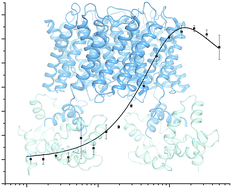当前位置:
X-MOL 学术
›
Faraday Discuss.
›
论文详情
Our official English website, www.x-mol.net, welcomes your
feedback! (Note: you will need to create a separate account there.)
Protein–protein interactions in AQP regulation – biophysical characterization of AQP0–CaM and AQP2–LIP5 complex formation
Faraday Discussions ( IF 3.3 ) Pub Date : 2018-04-25 , DOI: 10.1039/c8fd00065d Stefan Kreida 1, 2, 3, 4 , Jennifer Virginia Roche 1, 2, 3, 4 , Caroline Olsson 1, 2, 3, 4 , Sara Linse 1, 2, 3, 4 , Susanna Törnroth-Horsefield 1, 2, 3, 4
Faraday Discussions ( IF 3.3 ) Pub Date : 2018-04-25 , DOI: 10.1039/c8fd00065d Stefan Kreida 1, 2, 3, 4 , Jennifer Virginia Roche 1, 2, 3, 4 , Caroline Olsson 1, 2, 3, 4 , Sara Linse 1, 2, 3, 4 , Susanna Törnroth-Horsefield 1, 2, 3, 4
Affiliation

|
Protein–protein interactions play important roles in regulating human aquaporins (AQP) by gating as well as trafficking. While structural and functional studies have provided detailed knowledge of AQP transport mechanisms, selectivity as well as gating by conformational changes of loops or termini, the mechanism behind how protein–protein interactions control AQP-mediated water transport through cellular membranes remains poorly characterized. Here we explore the interaction between two human AQPs and regulatory proteins: the interaction between AQP0 and calmodulin, which mediates AQP0 gating, as well as the interaction between AQP2 and LIP5, which is involved in trafficking. Using microscale thermophoresis (MST) and fluorescence anisotropy, two methods that have the advantage of low sample consumption and detergent compatibility, we show that the interactions can be studied using both full-length AQPs and AQP peptides corresponding to the regulatory protein binding sites. However, full-length AQPs gave better reproducibility between methods and for the first time revealed that AQP0 binds CaM in a cooperative manner, which was not seen in experiments using peptides. Our study highlights that, while peptides are great tools for locating binding sites and pinpointing interacting residues, full-length proteins may give additional insights, such as binding mechanism, allostery and cooperativity, important parameters for understanding protein–protein mediated regulation in the cellular context. Our work provides a platform for further studies of AQP regulation that may be of interest for designing drugs that target AQP complexes as well as the development of artificial bio-mimetic water channels for water-purification purposes.
中文翻译:

AQP调节中的蛋白质相互作用– AQP0–CaM和AQP2–LIP5复合物形成的生物物理特征
蛋白质间相互作用通过门控和运输在调节人类水通道蛋白(AQP)中起着重要作用。尽管结构和功能研究提供了有关AQP转运机制,选择性以及通过环或末端构象变化进行选通的详细知识,但蛋白质与蛋白质相互作用如何控制AQP介导的通过细胞膜的水转运的机制仍然很差。在这里,我们探讨了两个人类AQP和调节蛋白之间的相互作用:AQP0和钙调蛋白之间的相互作用(介导AQP0门控)以及AQP2和LIP5之间的相互作用(涉及贩运)。使用微尺度热泳(MST)和荧光各向异性,这两种方法的优点是样品消耗量低和去污剂相容性高,我们显示可以使用全长AQP和对应于调节蛋白结合位点的AQP肽研究相互作用。但是,全长AQP在方法之间具有更好的可重复性,并且首次揭示AQP0以协作方式结合CaM,这在使用肽的实验中未见到。我们的研究强调,尽管肽是定位结合位点和精确定位相互作用残基的重要工具,但全长蛋白质可能会提供更多见解,例如结合机制,变构和协同作用,了解细胞背景下蛋白质-蛋白质介导的调控的重要参数。
更新日期:2018-09-28
中文翻译:

AQP调节中的蛋白质相互作用– AQP0–CaM和AQP2–LIP5复合物形成的生物物理特征
蛋白质间相互作用通过门控和运输在调节人类水通道蛋白(AQP)中起着重要作用。尽管结构和功能研究提供了有关AQP转运机制,选择性以及通过环或末端构象变化进行选通的详细知识,但蛋白质与蛋白质相互作用如何控制AQP介导的通过细胞膜的水转运的机制仍然很差。在这里,我们探讨了两个人类AQP和调节蛋白之间的相互作用:AQP0和钙调蛋白之间的相互作用(介导AQP0门控)以及AQP2和LIP5之间的相互作用(涉及贩运)。使用微尺度热泳(MST)和荧光各向异性,这两种方法的优点是样品消耗量低和去污剂相容性高,我们显示可以使用全长AQP和对应于调节蛋白结合位点的AQP肽研究相互作用。但是,全长AQP在方法之间具有更好的可重复性,并且首次揭示AQP0以协作方式结合CaM,这在使用肽的实验中未见到。我们的研究强调,尽管肽是定位结合位点和精确定位相互作用残基的重要工具,但全长蛋白质可能会提供更多见解,例如结合机制,变构和协同作用,了解细胞背景下蛋白质-蛋白质介导的调控的重要参数。











































 京公网安备 11010802027423号
京公网安备 11010802027423号